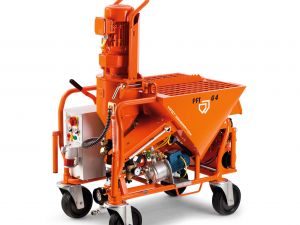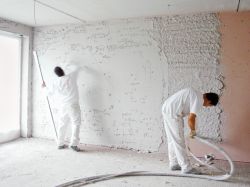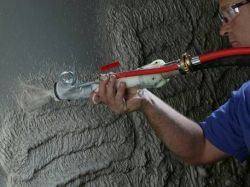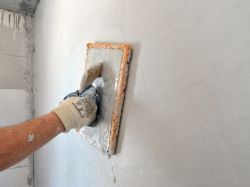
Machine plastering is a process for applying different types of prepared mortar on wall and ceiling surfaces. Mortars are supplied in bags or using silos. In this way the site of the construction remains clean. During the presentation, on all edges safety angle profiles (windows, doors, columns, beams, and angles) are set. Thus, the higher quality of mortar application is achieved as well as its higher impact resistance.
The mortar material has multiple advantages:
- thermal insulation
- protection of walls against weather
- protection of walls against mechanical damage
- high durability and permanence
- ensuring water vapor permeability
- aesthetic role
Depending on the purpose of an object and preference of investor, there are the following types of materials:
1. Cement - lime mortar
Designed for internal and external plastering of walls and ceilings in all rooms (Including wet rooms). Finishing process of this type of mortar can be roughly scraped (base for ceramics) or felted.
2. Gypsum lime mortar
It is intended for internal plastering of walls and ceilings in every room where there is no moisture. This type of mortar best regulates the microclimate in residential areas in a way that it takes moisture from the air when it has a surplus, that is, surrender when there is not enough. Finishing process of this type of mortar can be smoothened (smoothening) or felted (structure up to 1mm).
3. Cement mortar
Designed for all conditions where there are high demands in terms of strength, impermeability, frost resistance, water resistance (the foot of the building or area sprayed with water).
4. Heat mortar - Thermal mortar
Intended for interior and exterior plastering. As inner mortar it is used for plastering external perimeter walls, plastering the walls in the object between two flats or staircases as thermal insulation. For external plastering it is used as a subject to mortar in thermal façades systems.
Machine plastering, unlike manual plastering technique, is several times faster working technique. Except speed, price and efficiency are decisive factors in selecting these techniques.
In addition, the benefits of machine plastering are:
- Better handling of bulk material (higher degree of utilization)
- Achievement of excellent results in terms of smooth, flat and uniform plastered surfaces
- Significantly higher daily output
- The drying process of mortar is faster
- Uniformed and homogenous quality of the material
- The mortar mixture fully corresponds to the manufacturer's recommendations, thus achieving the highest quality
- Usage of factory prepared mixture makes an ideal base for colors intensity and easy maintenance
- Lower labor costs



